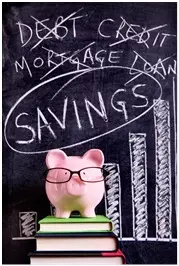
Get rid of your debt faster with debt relief
Choose your debt amount
Or speak to a debt consultant 844-731-0836
- 6 min read
- Learn about different consolidation options, reviewing their pros and cons.
- Understand the details of your current financial situation.
- Find the option for getting out of debt that is consistent with your goals, priorities, and capabilities.
- Start your FREE debt assessment
How to Consolidate Debt: 3 Steps to Debt Consolidation
We all face the challenge of making ends meet. Some of us spend more than we earn, resulting in substantial debt from credit card bills, personal or auto loans, or other bills. Medical debt can cause significant problems, as can job loss or a cut in income or hours. Some of us end up in debt because of bad spending habits, buying things we don’t need, or just not keeping track of where our money goes.
If you are carrying a lot of debt, you are not alone. According to the NY Federal Reserve Household Credit Report, US consumer debt at the end of Quarter 1, 2020, was $14.3 trillion.
Once you are in serious debt, breaking out of the cycle can be very hard and also depressing. If you are carrying debt and only making the monthly minimum payment, you will end up paying a ton of interest, if you don’t make some substantial changes.
Debt consolidation is one way to deal with your debt. Figuring out how to consolidate debt the best way requires you to scrutinize your situation. Here are three steps to take to consolidate your debt, so you get out of debt sooner and at a lower cost:
- Learn about different consolidation options, reviewing their pros and cons.
- Understand the details of your current financial situation.
- Find the option for getting out of debt that is consistent with your goals, priorities, and capabilities.
Step I: Learn about Debt Consolidation and Debt Relief Options
Because there are only a small number of ways for you to get out of debt, it makes sense to look at each one. It won’t take long and is the smartest way to make a fully informed decision. The options you should consider include:
- Debt consolidation programs offered by debt relief professionals, such as debt management and debt settlement.
- Do it yourself by optimizing your payment schedule.
- Borrowing money in a way that improves your financial position, such as a cash-out mortgage loan or an unsecured debt consolidation loan.
- Filing for bankruptcy.
Here is a quick summary of your major debt relief options:
Major Debt Consolidation programs:

Snowball or avalanche payment schedule: If you can pay more than the minimum required payments, you can pay off your debt faster. Two options are the avalanche and snowball strategies. You can either pay off the lowest balance debt first, and the next lowest, or start by paying off the account with the highest interest.
Cash-out Mortgage Refinancing: If you have equity in your house, then borrowing from your home's equity may be your best debt consolidation option. However, you have to be very disciplined to make sure that you don't run up new debt, once you have paid off your old debts by rolling them into your mortgage.
Personal loan: This is another common debt consolidation solution. A borrower with strong credit can take out one unsecured loan to pay off smaller debts. Rates are higher than on mortgage loans but can be far lower than on high-interest credit cards. Once again, if you run up new debt on the accounts you pay off in the consolidation, you will have the loan and the new credit card debt payment.
Bankruptcy: There are different types of bankruptcy, Chapter 7 and Chapter 13. Under all bankruptcies, you will have to show hardship and inability to pay off your debt. A chapter 13 bankruptcy will restructure your debt and allow for payments over several years, while a Chapter 7 will wipe out your debts, but may force you to liquidate assets you own.
Debt Management: Consumer Credit Counseling firms offer a debt management program (DMP). Before determining if a DMP is right for you, credit counseling starts with an analysis of your income, spending, debts, and credit. Your credit counselor will recommend a DMP to help you repay your unsecured debt, such as your credit cards and unsecured loans if it enables you to pay off your debt more efficiently. The credit counseling company can arrange interest rate reductions on your accounts and may even get some fees waived. You make one payment to the debt management company, who then pays off your different creditors. You will pay off 100% of your debt at more favorable terms, becoming debt-free faster.
Debt Settlement: Debt Settlement programs negotiate reduced balance payoffs with your creditors. You stop making monthly payments to your creditor and instead transfer funds to a special-purpose bank account that is under your control. After settlements are reached, the funds are used to pay the creditors. Your debt settlement company handles negotiations with your creditors, but your creditors can continue with the collection process. In the end, a debt settlement program can save thousands of dollars, getting you out of debt at the lowest cost while avoiding bankruptcy. Reputable debt settlement firms do not take any up-front fees, only getting paid for their work on an account after your settlement is finalized, and you approve it.
Step II: Get Control of Your Financial Situation
To figure out how to consolidate debt in a way that is best for you, you first need to know:
- Exactly what you owe and at what interest rate
- To whom you owe the money
- Your monthly cash flow
Here are some guidelines to the second step of how to consolidate debt:
Balance Sheet: How much do I owe? Make a list of all your assets on one side, and all of your debts on the other side. Include in the table your loan amount, interest rate, monthly payment, and the number of months till payoff.
Cash flow: How much can I pay? Make a budget. Bills.com's budget guide shows you all the steps to creating and maintain a budget.
Credit score: Weigh the impact on your credit for the solutions you are considering. Some solutions will harm your credit. Be sure you know your current credit rating. If it is already damaged, then further harm to it may not be as significant as the debt relief you realize. If you have strong credit, income, and own assets, different options are available to you than if your credit is already damaged and you're struggling to pay your bills.
Goals: Do you have court judgments? Debt collection letters/calls? The deeper you are into the collection process, the fewer options you have for debt consolidation. Here are some goals to consider:
- Manageable monthly payment: Can you meet your current monthly payments, or do you need to lower them?
- Cheapest solution: Are you willing to face harsh collection practices to save the most money?
- Earliest solution: How important is it for you to find a solution that will get you out of debt as quickly as possible?
- Credit rating: Are you willing to have your credit score hurt?
- Stress: How well do you handle stress? Can you deal with the creditor's collection calls?
Step III: Choosing a Debt Consolidation Option
The third step to learning how to consolidate debt can be the hardest. You must choose a solution. Making the smartest decision is easier when you are adequately prepared. That is why you must know the pros and cons of each option available and understand your own goals, priorities, and capabilities. Careful preparation leads you to ask the right questions of any professional firm you consider. It also gives you the framework to gauge how likely you will be to see the solution through to completion, whether you use professional help or work the problem on your own, and find a debt relief solution best suited to your needs. The bottom line- debt consolidation and staying debt free is up to you.
» SUGGESTED: Claim your free debt assessment by Bills.com

Get rid of your debt faster with debt relief
Take the first step towards a debt-free life with personalized debt reduction strategies.
Choose your debt amount
Or speak to a debt consultant 844-731-0836